Peter MALONE
Saturday, 18 September 2021 19:58
Big Shakedown, The
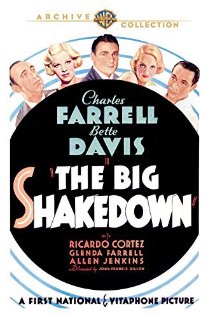
THE BIG SHAKEDOWN
US, 1934, 61 minutes, Black and white.
Bette Davis, Charles Farrell, Ricardo Cortez, Glenda Farrell, Allen Jenkins, Henry O' Neill.
Directed by John Francis Dillon.
The Big Shakedown is a brief drama with touches of the thriller from 1934, a star vehicle for Charles Farrell was something solid star vehicle for a young Bette Davis, doing a contract role that anyone might have done, but bringing a strong presence. Ricardo, Cortez is the villain, running rackets, especially with beer but discovering that the hero, the store owner, was able to make products, even toothpaste, less expensively and employs him to produce toothpaste and other goods, selling them with false labels
The film shows production, sales, the money coming in, the decision to have a wide range of products. Davis is against what is happening but still marries her fiance, is pregnant, gives birth but loses the child because of one of the fake products being ineffective. Glenda Farrell has role of the girlfriend who is discarded and reports the racket to the police, but is shot.
The director, John Francis Dillon, made silent films. This was his last film.
1. Thriller of the 1930s, with bootlegging background, gangster background, the aftermath of the Depression?
2. Warner Brothers, the 1930s, the city setting, the shops, offices, factories? The musical score?
3. The title, ordinary citizens, gangsters, rackets, pressures?
4. Introduction to Jimmy and Norma, at the store, the range of customers coming in, the various needs, no money-making, the boy with the ice cream and stamps? Norma and her being nice to everyone? Jimmy and his ambitions? The planned marriage?
5. The company representative, the offer to buy up the store, the poor price, refusal?
6. Introduction to Dutch Barnes, his henchmen, standover tactics, coming to the store and meeting Norma, the beer, the pressure to change companies? Dutch and the meeting, the challenge about the beer, the many companies producing? His headache, going to the shop, the asperin, meeting Jimmy, discovering what Jimmy could make?
7. The plan, the fabrication of the toothpaste, Jimmy’s demonstration, his unwillingness to participate, his being told that he was innocent, simply making goods, and it was Dutch and others who sold them?
8. Jimmy, participation, his ideas, the many products, Lil and the face cream, the factories and production, the labels, the fraud, the success, the money coming in?
9. Norma, the disagreeing, loving Jimmy, the wedding, the pregnancy, in hospital, the fake digitalis, the loss of the child?
10. Jimmy, the discussions with Dutch, his being persuasive, Jimmy wanting to get out?
11. Little, the character, with Dutch, being discarded, going to the police, Dutch and the setup for the death, her being shot in the street?
12. The international company, the representative, the meetings, interrogating Jimmy, getting him to become a witness?
13. The final confrontation with Dutch, Jimmy with the gun, Dutch being shot, the representative shooting Dutch?
14. The arrests, the court case, the headlines, the prison sentences and the henchmen seen in the prison, Jimmy released, the happy reunion with Norma,
his store and reconstituting it as a service for the needs of people?
15. Morale-boosting story for the difficulties of gangsters and rackets in the 1930s?
Published in Movie Reviews
Published in
Movie Reviews
Tagged under
Saturday, 18 September 2021 19:58
Gift of Miracles, A
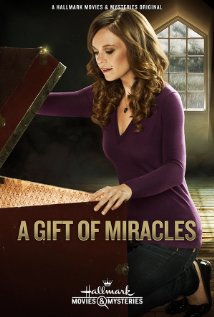
A GIFT OF MIRACLES
Canada, 2015, 100 minutes, Colour.
Rachel Boston, Jesse Moss, Andrew Airlie, Sarah- Jane Redmond, Rita Moreno.
Directed by Neill Fearnley.
A Gift of Miracles is one of those pleasing entertainments for the widest possible audience, a film that is built on sentiment, the kind of film that many critics dismiss as too sentimental, even too religious and optimistic in its perspective.
Rachel Boston portrays a science student, daughter of an academic whose mother was killed in a car accident when she was young. She is working on her presentation for her doctorate and her supervisor advises her to go to someone in the English department to help her with her writing. Jesse Moss portrays the member of the English faculty who is all into feelings while she is extremely thinking and objective, wanting only the facts.
In the meantime, she is clearing out some of her mother’s possessions and comes across a list of things to return – she begins to return them, stories opening up, connections with her mother and the kind of person she was. Her aunt supports her – and is always interested in matchmaking. When she meets Nathan, the English Department man, again, he makes a bet with her about finding all the people on the list and her discovering more about herself.
There are many coincidences in the film, or what Jung would call synchronicity, so that she has moments when she doubts that everything is absolutely clear and rational and breaks with Nathan. However, there is the ultimate synchronicity when she looks at the photo of her mother’s garden and finds that it is the house when Nathan and his mother now live.
There is a pleasing cameo by Rita Moreno.
There are more things in this world… And can be explained by mere reason.
1. An entertainment? The moral message?
2. The Canadian town, University, homes, markets, authentic atmosphere? Musical score?
3. The title, philosophy, science, the rational versus the emotional, instincts and feelings, coincidences and synchronicity? The universe to be explained entirely rationally, or things meant to be…?
4. The character of Darcy, rational, her relationship with her father, his academic background, emphasis on facts, the death of her mother, the accident, not believing in emotions? The thesis, science, on the topic, facts and theories, her friend and co-worker, her supervisor, the advice for a rewrite of her presentation? His stances?
5. Nathan, background in literature, his age, his job at the University, the intervention of his mother, her calls, living with her? To advise Darcy? His reaction to her presentation, urging passion and emotion? Darcy’s reaction? Giving up, the supervisor urging her on? Her meeting Nathan by chance?
6. At home, the story of her mother, the car accident, teacher, caring for her daughter, caring for friends, the gardens, cooking? Darcy clearing things out, the discovery of the box, her mother’s things, the list of people and the intention to return them?
7. Darcy’s decision to return the things, searching for the people, the process? The encounter with Nathan, his challenge to her, the bet, his helping?
8. Her aunt, the encouragement, explanations, match-making?
9. The range of different people she met, Beverley and the choice about the flowers, seeing Beverley at the cemetery, the address, discovery her at the house, the gradual revelation that it was her son who killed Darcy’s mother, the reaction of each, Darcy visiting her again, the bond between them?
10. The recipe, going to see the friend, the discussions? Going to the mechanic, the biscuits, his memory of Darcy’s mother and looking after him? Looking for the address to return the chairs, tracking the man down, his urging her to keep chairs? The effect of all the coincidences? Talking to Nathan, talking to her father?
11. Darcy, the attraction to Nathan, the irony of his living in her mother’s house, the photo of the garden?
12. Writing the presentation, his being accepted, with her father, the break with Nathan, the return? Her success?
13. The breakthrough in her development of character, both rational and emotional, her puzzle about synchronicity and providence? The title?
Published in Movie Reviews
Published in
Movie Reviews
Tagged under
Saturday, 18 September 2021 19:58
Krays, The
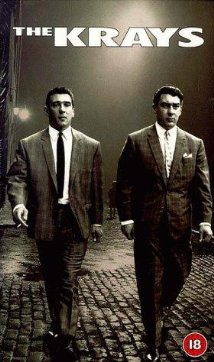
THE KRAYS
UK, 1990, 119 minutes, Colour.
Gary Kemp, Martin Kemp, Billie Whitelaw, Tom Bell, Susan Fleetwood, Charlotte Cornwell, Kate Hardie, Avis Bunnage, Alfred Lynch, Steven Berkoff, Barbara Ferris, Victor Spinetti, John Mc Enery.
Directed by Peter Medak.
In this film about the notorious Kray brothers, who dominated London and the crime scene in the 1960s and would become celebrities, and not averse to being photographed with mainstream celebrities, were still alive, Reggie in prison and had been since the 1960s and who was to still spend more than a decade years in prison after the release of the film, and Ronnie who was in a mental institution.
The Kray brothers were twins and so Gary and Martin Kemp, with audience memories of the group, Spandau Ballet, portraying the brothers. But, one of the main emphases in the screenplay is the portrait of their mother, Violet, portrayed vividly by Billie Whitelaw.
The film traces their career, the influence, the protection rackets, the killings…
The film also introduces the young woman in love with the Reggie, Frances, Kate Hardie, who eventually married him, perhaps with the hope of changing him but who became more and more disillusioned and took her life.
One of the main features of the film is the range of British character actors in supporting roles. Director Peter Medak had a varied career making popular films and television movies as well as the classic, The Ruling Class with Peter O’ Toole.
There have been a number of documentaries about the Krays but 2015 saw an ambitious portrait of them and their work with Tom Hardy playing both of the brothers, Reggie looking like his regular self and make up and glasses and hairstyle changing for his portrayal of Ronnie. In this film, Legend, Frances is played by Emily Browning. And it is as far more visual and its presentation of violence, murders by both Reggie and Ronnie.
1. The impact of the film and its time? The reputation of the Krays? In the 1960s, subsequent decades? The twins still alive at the time of the film’s release?
2. True story, psychological portrait, gangster portrait?
3. The 1960s, London at the time, the East End, the world of crime? The detailed flashbacks to their childhood, the war? The subsequent history?
4. The facts, dramatised? Truth, validity? Visual presentation presenting the Krays realistically? The possibility of glamorising them?
5. The strong British cast, the Kemp twins as the Krays? Billie Whitelaw as their mother?
6. London, the period, the war and the blitz, the 1960s, costumes, cars, clubs? The musical score and the period?
7. Violet Kray as the focus of the film? Love for her children, possessive, protective, the war, the blitz experience, at home? The strong woman, surrounded by strong women, her considering men weak? Cosseting her sons?
8. Violet as a character, matriarch, love, protection, domination, influence, learning the truth, reactions?
9. The Krays as adults, their experience in London, the style of the 60s, as characters, twins and bonds?
10. The brothers as adults, each character, Reggie as a leader, strong, the brains? Ron and his psychological difficulties, treatment, madness combined with gangsterism?
11. Ambitions, self-worth? Domination in the East End, over London? Decisions, protection, the violence, their associates, the thugs, the money?
12. The police, the personalities, the pursuit?
13. The experience of jail, mental institutions?
14. The possibility of Mafia links? But the American approach more flamboyant than that of the British?
15. The details of crime, the creation of fear, exercising power, Jack and the others, Reggie’s behaviour? The entrepreneurs and working for protection, gambling, accounts? The brothers turning on people?
16. Court cases, witnesses, acquittal?
17. The presence of Frances, her family background, the connection with Reggie, her aims in life, love for Reggie, support, enjoying the privilege, the marriage, his treatment of her, her death?
18. A portrait of petty criminals who achieved some prominence, some celebrity, popularity?
19. Yet the brutality, the killings, the imprisonment and internment? The purpose of making this film?
Published in Movie Reviews
Published in
Movie Reviews
Tagged under
Saturday, 18 September 2021 19:58
Good People
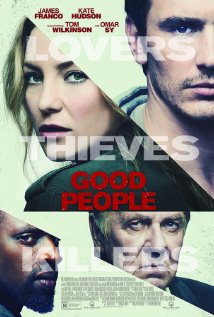
GOOD PEOPLE
US/UK, 2014, 90 minutes, Colour.
James Franco, Kate Hudson, Tom Wilkinson, Omar Sy, Sam Spruell, Anna Friel, Diana Hardcastle.
Directed by Henrik Ruben Genz.
Good People is a crime drama set in London, although the central characters, James Franco and Kate Hudson, play Americans who have inherited a house and have decided to settle in London, he a restorer of houses and she a teacher who has suffered a miscarriage.
In the meantime with a robbery at a club, drugs and cash, with one of the robbers shooting another and getting away with everything. In fact, he boards in the basement of the house where Franco and Hudson live and dies of an overdose. When they find the bag of money, their eventually decide to keep it. In the meantime, a police officer played by Tom Wilkinson has been after the criminals, especially with the death of his daughter from an overdose. He interrogates the couple and persuades them, especially after thugs come and bash Franco, to deliver the cash but have a guard watching. It goes astray, Wilkinson is shot, and the couple hide in the house in the suburbs that they have inherited. In the meantime, an African dealer who calls himself Genghis Kahn threatens them and wants revenge on the robbers.
The end has quite a confrontation, the wife being upstairs with a gun, the husband in the basement but loosening the floor so that one of the thugs falls through - and stapling the feet of another to the floor. And in comes Wilkinson with his gun.
A strong cast, James Franco appearing in many films at this time as well as writing and directing. He works well with Kate Hudson and Tom Wilkinson. Omar Sy who made such an impression in The Intouchables is the African criminal. The director is Danish.
1. The title, audience expectations? The criteria for good and bad?
2. London setting, homes, suburbs, houses restored, is, ordinary world, Kingston world, police officers, the parks? The musical score?
3. The introduction to the couple, Americans in England, the inheritance of this, the experience of the miscarriage, attempts to become pregnant, she teacher, you restore Holmes?
4. The robbery, gangsters waiting outside, Khan and his arrival,, the men going in, the types, the shooting, leaving?
5. The irony of the robbery, cash and drugs, the boarder in the basement, drugs and his death, Tom finding him, the bag and the money in the roof, the moral dilemma about keeping it or not? The discussions with Anna, the time limit, not foreseeing consequences? The plan for the eviction, the money saving them?
6. John, police, the enquiry, checking the house, his attitude towards the criminals, relationship with his wife, the death of his daughter, the drugs and dealing, his anger, the policeman, wanting to stay on the case, the clashes with the authorities?
7. Tom and Anna, the characters, their background, the experience of the miscarriage, Tom and his work, the need for jobs, his associate? Waiting, the deciding, the conditions? Using the money for small payments, his co-worker, the jobs?
8. Khan, personality, after the criminals, background, self-confidence, contacting Tom, the interview with him, the explanation of Genghis Khan, that people were with him or against him? The threats? Revenge on the London criminals?
9. The London criminals, the visit to Tom, the brutality and threats?
10. John, knowing the truth, Tom telling him the details, Tom wounded, the explanations, the plan for the delivery, the deals, in the Park, the shooting and chaos, John being wounded, John and going to the mansion?
11. John in hospital, his wife, his decision to go to help Tom?
12. Coming to the mansion, the thugs coming, Anna upstairs, the confrontation with the thug, with Khan? The thug, falling through the floor of the basement, Tom stapling the feet? The gun, Anna, the shooting? John and his arrival?
13. The mansion, John driving, crash, the deaths? Shooting? John giving Tom and Anna the small amount of money for the future?
14. Who are good people? Who are bad people?
Published in Movie Reviews
Published in
Movie Reviews
Tagged under
Saturday, 18 September 2021 19:58
This is My Affair
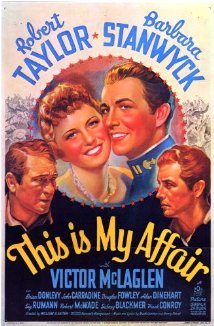
THIS IS MY AFFAIR
US, 1937, 100 minutes, Black and white.
Robert Taylor, Barbara Stanwyck, Victor Mc Laglan, Brian Donlevy, John Carradine, Sidney Blackmer, Frank Conroy.
Directed by William A. Seiter.
Later generations would consider this film as historical but the events portrayed in the film took place only 35 years before the production in 1936.
We are taken back to the presidency of William Mc Kinley. He is concerned about a series of bank robberies and he persuades a naval officer to go undercover and solve the mystery. He is played by Robert Taylor in an early role and is pared with Barbara Stanwyck who was to become his wife. They were to play together, long after their divorce, in the 1964 Night Walker.
And Taylor goes undercover in Kansas City and St Paul, meeting the criminals, Brian Donlevy and Victor Mc Laglan (who had just received an Oscar for The Informer but, as so often, he seems to overact very buoyantly). Barbara Stanwyck is associated with them, and sings in a club. And Taylor ingratiates himself with the group, even stealing jewels in a store, but he begins to fall in love with Stanwyck.
The plot involves the group having a mastermind, a scout in American cities to find banks to rob, setting up a robbery with a shootout and police. While Donlevy is killed, Mc Laglan and Taylor go to prison – and the film gets more exciting with the news of the death of President Mc Kinley, Taylor sending him a letter with information, his persuading Stanwyck, even though she is angry with him, to go to see President Roosevelt to find the letter. The priest comes for the last rites, Mc Laglan is hanged – and Taylor receives reprieve just-in-time.
Entertaining – but not quite as good as one hoped might be.
1. American history, 35 years after the events, President Mc Kinley and his memory, Theodore Roosevelt as President?
2. Thirties’ production, black and white, the recreation of 1901, Arlington Cemetery, the period, Washington DC, White House, interiors, socials? Kansas City and types, clubs, songs and dances, banks, crime, prisons? Clubs, song and dance, the banks, crime, prisons?
3. The musical score, the songs?
4. The title, Richard’s comment about his vision? Telling Lil?
5. The opening at the cemetery, the nun’s and girl’s and the mysterious grave? The situation, the social at the White House, the crisis, the bank robberies,
the President and his concern, investigation, summoning Richard, his career, scrapes, his explanations? His being hired, sworn to secrecy? The planned letter, the sign on the letter?
6. Richard as a character, accepting the investigation, his posing as criminal, gambling, tough, the variety of tangles and contacts? Gambling? St Paul? Meeting with Jock, with Batiste, meeting people? Ingratiating himself, his plans, to uncover the criminals, the mastermind? Stealing the jewels, the clashes, Batiste persuading him to return the jewels? His becoming credible to them, part of the gang, going into action, caught by the police, the shootout? His arrest, in prison, the visit of Lil? The priest and his sitting with him, confessing to Lil, and, the reprieve? The end and his finding her singing?
7. Jock, buoyant, his practical jokes, dumb, tough, criminal life?
8. Lil, the relationship to Batiste, the singing and dancing, becoming involved, liking Richard, falling in love?
9. The criminal scout, the information, reporting about the banks, the variety of plans?
10. The jewels, the people in the shop, Richard stealing, the police, the contacts, the confrontation, the return of the jewels?
11. The shootout, Batiste being wounded, dead?
12. Prison, the cells and bars, Richard and his putting pressure on Jock, Jock his reflections, Richard leading him on, to expose the mastermind? Jock and his being with the priest, reacting, his card trick, not wanting the priest, the priest and forgiveness?
13. Richard, the letter to the President, its being sent? The guards, the warden, Lil’s visit, the truth and her anger?
14. The assassination of the president and Richard desperate?
15. Lil going to Dewey, going to the President, their thinking her a fake, the phone call to Alexander, his not remembering, phoning back, the stay of
execution, Roosevelt’s apology?
Published in Movie Reviews
Published in
Movie Reviews
Tagged under
Saturday, 18 September 2021 19:58
Dance, Fools, Dance
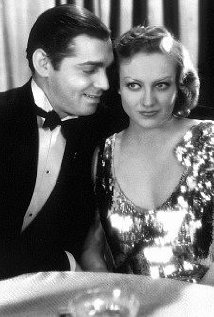
DANCE, FOOLS, DANCE
US, 1931, 80 minutes, Black and white.
Joan Crawford, Lester Vail, Cliff Edwards, William Bakewell, Clark Gable.
Directed by Harry Beaumont.
Joan Crawford had been in films for some years, working at MGM, in silent films and then in dramas and musicals. This was a more prestigious production and led to her becoming a significant star at MGM.
She portrays a carefree daughter of a millionaire working the stock exchange. Frivolous with her reckless brother, William Bakewell, at parties, using the services of bootleggers. She plays Bonnie who is the object of affection by a man about town, Bob, played by Lester Vail.
The stock market crashes, the father dies, leaving his children no money. Strong-minded, Bonnie goes to work at a newspaper, befriending one of the best reporters, who is called to cover murders which resemble the St Valentines Day Massacre (which actually occurred prior to the Wall St crash). Her irresponsible brother makes contact with his bootlegger and goes to work with a tough gangster, played intensely by Clark Gable, Gable’s performance means that he is obviously a star. Bonnie goes undercover, dances at Gable’s club, discovers the irresponsibility of her brother and is present when there is a shootout. She gives the information to her paper and to the police – and her suitor, who had condescended to offer marriage in the past, now genuinely loves.
The film is interesting for Joan Crawford fans – she has to play an extravagant playgirl, a serious newspaper reporter, and undercover moll, giving her dramatic, musical and dramatic opportunities to perform. The film was directed by Harry Beaumont, director of a number of films at this time including the Oscar-winning Broadway Melody of 1929.
1. An entertaining melodrama of its time? The aftermath of the crash of 1929?
2. MGM production values, Joan Crawford as star, Clark Gable on the rise? Black-and-white photography, locations, New York City, mansions, newspaper offices, clubs? The musical score? song and dance?
3. The irony of the title, the Americans at the time of the crash, recklessness before, hardships afterwards?
4. The opening parties, Bonnie and her behaviour, Bob in love with her? The father and his exasperation, Rodney and his boot legging connections?
5. Wall Street, the crash, the father’s death, funeral, the reading of the will, no money, Rodney unwilling to work? Bonnie deciding to work?
6. The role of the newspaper, writing stories, the editor cutting them down, her friendship with Ben, going out with him, talking? His advice, succinct stories? The news of the massacre, the editor sending out the men? His sending out Bonnie, to go undercover?
7. The quick transition, her becoming a dancer at Jake’s club, Bob seeing her, the others spurning her – after buying things at the auction of all the furniture and goods? Her ingratiating herself with Jake, his infatuation, going to his apartment, answering the phone, Rodney wanting Jake, her shock?
8. The background of Rodney, his job, instructed to keep quiet, driving the car at the massacre, talking with Ben at the bar, Jake and his decision for Ben to be killed, pressurising Rodney to kill him, at the subway, the murder, Rodney and his panic?
9. Bonnie getting out of the window, going to her apartment, Rodney, Jake and his thugs arriving, Bonnie knocking the gun, Rodney shooting Jake and his associate, Rodney being killed?
10. Bonnie phoning the press, the story, the editors and their admiration for her? Bob’s arrival, her previously thinking he was not genuine, the love for him, the kiss – and the happy ending?
11. A moralising story from MGM during the depression and the bootlegging era?
Published in Movie Reviews
Published in
Movie Reviews
Tagged under
Saturday, 18 September 2021 19:58
Hide-out
HIDE-OUT
US, 1954, 89 minutes, Black and white.
Robert Montgomery, Maureen O' Sullivan, Edward Arnold, Elizabeth Patterson, Whitford Kane, Mickey Rooney, Edward Brophy, Herman Being.
Directed by W. S. Van Dyke.
Hideout begins as a gangster film of the 1930s, Chicago, protection rackets, with a suave gangster, Lucky Wilson (Robert Montgomery) as a standover man for pressurising clubs for protection money. He is also a womaniser, with a roving eye, especially for blondes. The police, in the form of Edward Arnold and Edward Brophy, are trying to catch him. When he escapes from the police, he is wounded and crashes his car in Connecticut.
He is taken in by a farming family, all kindness, Whitford Kane as the Irish father, Elizabeth Patterson as the all-concerned mother, Mickey Rooney, in one of his many junior roles at this time, as the young son who does what not want to be called WSillie. And Maureen O’ Sullivan is the attractive daughter, a teacher.
Wilson is attracted to the daughter, decides to stay, even involves himself in doing the farm chores with her even though he is clueless. He falls in love, the police arrive, a kindly cover-up for him and don’t reveal the truth to the family, yet he reveals the truth to the daughter and she promises to wait for him.
The gangster aspects are rather well done – but the transition to the homely family gives the film are quite different tone.The film was directed by W. S. Van Dyke, a prolific director at MGM at this period, especially the comedies and for Jeanette Mac Donald- Nelson Eddy musicals.
1. An entertaining film with the mixture of the gangster and standover tactics with life with a nice family on the farm?
2. MGM production values, black-and-white photography, Chicago sets, farm? The musical score?
3. The title, the irony of the hideout being very nice and having a good effect on the gangster?
4. Lucky Wilson, Robert Montgomery and his suave style, talking with all the girls, the dates, abandoning them, going to the club, being well received, his meeting the two owners, their prosperity, then nervousness, his pressurising them for protection and taking in the partner? The singer, his date with her? Going to the hotel, the police, the chase, his being shot, taking the car, pursued into the country, his collapse?
5. The Miller family, the father phoning thinking it was the doctor, the doctor coming in urging him to stay undercover? The character of the father, benign, the farm? The mother, consistently concerned, doing everything for Wilson? Willie, his age, not wanting to be called Willie, the rabbits, one for dinner, crying, the bets with Lucky? Pauline, teacher, helping Lucky, the tensions, falling in love? Her doing the farm chores, his joining her, showing him how, feeding the chickens, milking the cows?
6. The credibility of his change within the week, falling in love with Pauline?
7. The arrival of the police, their personalities, wanting to get Lucky? The family after the day, returning, finding the police, the police surprised at the family taking in Wilson, their concern? The meal, the ironies of the conversation, his leaving, business, time away? The farewell to Pauline, telling her the truth, the family not knowing?
8. The kind touch of the police letting him say goodbye? The mother giving them a parcel for the trip?
9. Happy ending – and the moralising story about gangsters and their possible reformation, especially by falling in love?
US, 1954, 89 minutes, Black and white.
Robert Montgomery, Maureen O' Sullivan, Edward Arnold, Elizabeth Patterson, Whitford Kane, Mickey Rooney, Edward Brophy, Herman Being.
Directed by W. S. Van Dyke.
Hideout begins as a gangster film of the 1930s, Chicago, protection rackets, with a suave gangster, Lucky Wilson (Robert Montgomery) as a standover man for pressurising clubs for protection money. He is also a womaniser, with a roving eye, especially for blondes. The police, in the form of Edward Arnold and Edward Brophy, are trying to catch him. When he escapes from the police, he is wounded and crashes his car in Connecticut.
He is taken in by a farming family, all kindness, Whitford Kane as the Irish father, Elizabeth Patterson as the all-concerned mother, Mickey Rooney, in one of his many junior roles at this time, as the young son who does what not want to be called WSillie. And Maureen O’ Sullivan is the attractive daughter, a teacher.
Wilson is attracted to the daughter, decides to stay, even involves himself in doing the farm chores with her even though he is clueless. He falls in love, the police arrive, a kindly cover-up for him and don’t reveal the truth to the family, yet he reveals the truth to the daughter and she promises to wait for him.
The gangster aspects are rather well done – but the transition to the homely family gives the film are quite different tone.The film was directed by W. S. Van Dyke, a prolific director at MGM at this period, especially the comedies and for Jeanette Mac Donald- Nelson Eddy musicals.
1. An entertaining film with the mixture of the gangster and standover tactics with life with a nice family on the farm?
2. MGM production values, black-and-white photography, Chicago sets, farm? The musical score?
3. The title, the irony of the hideout being very nice and having a good effect on the gangster?
4. Lucky Wilson, Robert Montgomery and his suave style, talking with all the girls, the dates, abandoning them, going to the club, being well received, his meeting the two owners, their prosperity, then nervousness, his pressurising them for protection and taking in the partner? The singer, his date with her? Going to the hotel, the police, the chase, his being shot, taking the car, pursued into the country, his collapse?
5. The Miller family, the father phoning thinking it was the doctor, the doctor coming in urging him to stay undercover? The character of the father, benign, the farm? The mother, consistently concerned, doing everything for Wilson? Willie, his age, not wanting to be called Willie, the rabbits, one for dinner, crying, the bets with Lucky? Pauline, teacher, helping Lucky, the tensions, falling in love? Her doing the farm chores, his joining her, showing him how, feeding the chickens, milking the cows?
6. The credibility of his change within the week, falling in love with Pauline?
7. The arrival of the police, their personalities, wanting to get Lucky? The family after the day, returning, finding the police, the police surprised at the family taking in Wilson, their concern? The meal, the ironies of the conversation, his leaving, business, time away? The farewell to Pauline, telling her the truth, the family not knowing?
8. The kind touch of the police letting him say goodbye? The mother giving them a parcel for the trip?
9. Happy ending – and the moralising story about gangsters and their possible reformation, especially by falling in love?
Published in Movie Reviews
Published in
Movie Reviews
Tagged under
Saturday, 18 September 2021 19:58
Ten Cents a Dance
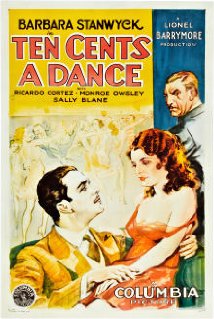
TEN CENTS A DANCE
US, 1931, 75 minutes, Black and white.
Barbara Stanwyck, Ricardo Cortez, Monroe Owsley, Sally Blane.
Directed by Lionel Barrymore.
This is an early Barbara Stanwyck film, on her way up to becoming a leading star for almost 50 years. He/she plays a dancer in a club, rather reluctant, but pressurised the madam who is in charge.
She meets a sympathetic businessman who pays attention to her. She is also kind to an out of work man, Eddie, whom she eventually marries. She persuades the businessman to give him a job. She leaves the dancing and sets up a house only to find that her husband is untrustworthy, has a roving eye, and steals money from his boss. She goes to the businessman and asks him to give her the money which he does. Ultimately, it leads to a confrontation between the two men, some gunplay, and realising that the businessman loved her and offers her a ticket to accompany him to Europe.
Barbara Stanwyck, as always, is very strong in her performance. Of interest, the film was made at Columbia and directed by Lionel Barrymore, who had directed a number of silent films but this was to be his last major directing. He was a star at MGM and continued there for the next 20 years.
1. An entertaining melodrama of the 1930s?
2. Clubs, dancers, apartments, business? Black-and-white photography, musical score, dance music?
3. The dances, the title and the fee, the clientele, sailors, ordinary men, paying the money, the girls, willing and unwilling to dance, the madam supervising them, strict?
4. Barbara as a character, dancing, lack of education in background, willing and unwilling, dancing, talking with Bradley, his interest and meeting with him? The friendship with Eddie? His being in need, getting on top, leaving, marrying, her hopes of an ordinary life, his unreliability, seeing other women, stealing the money?
5. Her going to Bradley, getting Eddie a job, asking him for the money, his knowing the truth, giving it to her?
6. The confrontation with Eddie, her telling him what happened, his going to Bradley, the confrontation?
7. Barbara, returning to the dancing, feelings of hopelessness? Bradley visiting again, talking, his love, offering the ticket to Europe?
8. A film of the 1930s – and the atmosphere of the depression?
Published in Movie Reviews
Published in
Movie Reviews
Tagged under
Saturday, 18 September 2021 19:58
Always Goodbye
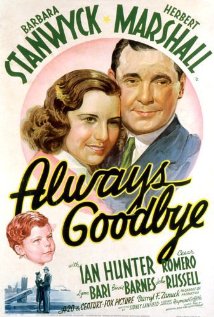
ALWAYS GOODBYE
US 1938, 76 minutes, black and white.
Barbara Stanwyck, Herbert Marshall, Ian Hunter, Cesar Romero, Lynn Bari, Binnie Barnes, Johnny Russell, Franklyn Pangborn.
directed Sidney Lanfield.
This is what used to be called a woman’s picture, a focus on a sympathetic central character and her struggles. This time it is Barbara Stanwyck, waiting on a New York Street for her husband-to-be for the wedding and his being killed in front of her in a car accident. She feels suicidal but is rescued by a kind scientist played by Herbert Marshall.
She gives up her baby for adoption to two friends of the scientist who also gets her a job in the high fashion store, managed by Binnie Barnes. He disappears on a voyage for five years, during which Margot is successful in the store, and is sent to Paris to buy fashions. By chance she encounters her son, has the opportunity to be with him, and on the voyage home. His adoptive father, Ian Hunter, is a widower and plans to marry Jessica, a golddigger.
He falls in love with Margot but she loves Jim and he her, but she opts to go with Roddy’s adoptive father, to be a mother to her child and never to reveal the truth.
The year before Barbara Stanwyck are played in Stella Dallas, a different story about bringing up an illegitimate child.
1. A so-called ‘woman’s picture’ In the past? The soap opera touches, drama, romance, melodrama?
2. 1938 setting, black and white photography, New York City, Paris? The musical score?
3. The title, Margot: losing her husband, losing Roddy, losing Jim?
4. The meeting in the street, crash, wanting to kill herself, rescued by Jim, the birth of the baby, the decision for adoption, the Marshall couple, her pledge not to reveal the truth, Jim getting her the job with Harriet, the work in the store?
5. Jim, the loner, doctor, the voyages with the cows, rescuing Margot, arranging the adoption, absent for five years, his return, Margot happy, his love for Margot?
6. Margot and her going to Paris, the fashion world, the encounter with the Count, the comic touches of his always turning up, flirting? Meeting of Roddy at the hotel, his nurse, ill, playing with him, the decision for the voyage, the bonding on the ship?
7. With Jim, the, wanting to have the Roddy, Jessica at the shop, her going to the bicycle store and meeting Philip, the meetings at the house, going biking with Roddy and Philip, the confrontation with Jessica about Roddy’s future, Philip hearing it, Philip and his love for Margot?
8. Jessica as a character, gold-digger, Philip has a catch, sending Roddy to military school, the flirtation with the Count?
9. Roddy and his verve? Bonding with Margot?
10. The Count, the comic touches, pursuit of women? Jessica?
11. Margot and her love for Jim, the promise not to tell Philip the truth, marrying him, being a mother to Roddy?
Published in Movie Reviews
Published in
Movie Reviews
Tagged under
Saturday, 18 September 2021 19:58
Oddball
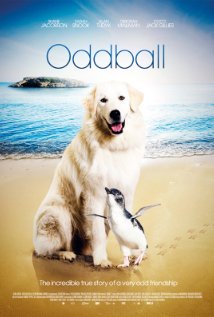
ODDBALL
Australia, 2015, 90 minutes, Colour.
Shane Jacobson, Sarah’s Luke, Alan Tudyk, Deborah Mailman,
Directed by Stuart Mc Donald.
Oddball is a very easy film to watch – especially if you love dogs and, an added bonus would be a love for the fairy penguins. This is mostly what the film is about.
The setting is the Victorian southern coast, along the Great Ocean Road, the coastal town of Warrnambool. Since much of the film was made there, along with a great deal of added footage of the 12 Apostles (or however many there are these days) which should do wonders for the Victorian Tourist Commission, with the backing behind the final credits continuous helicopter turns around the cliffs and the Apostles.
And, again, this is a true story, with a comment at the end that it served as an example for other organisations and local councils for protection of endangered creatures.
On the human side, the main star is Shane Jacobson, as Swampy Marsh, big and cuddly in many ways, memorable, of course, for being Kenny, but appearing in quite a number of films, including the Jack Irish television movies. This time he is the, scruffy, bearded, a local organic egg producer – with a large pet dog, a Mareeba, who is also cuddly - if one could get one’s arms around him. But when they go into town, Oddball inevitably causes all kinds of rumpus and destruction. We see him at a rehearsal for the opening of a model village, with all kinds of technical equipment, all up-ended and a lot of it in smithereens. At a local council meeting, Oddball is roundly condemned and confined to Swampy’s farm. But there is sympathy from the Mayor, who has a soft spot for Swampy (Deborah Mailman).
And as if acting with an animal and with penguins was not enough, Swampy also has one of those screen-cute granddaughters, Olivia (Coco Jack Gillies), living with her single mother who is the local officer on Middle Island, a walk through the tide from the beach, for the preservation of the Penguin Colony. The famous W. C. Fields’ dictum of not acting with animals or children does not seem to phase Shane Jacobson. In fact, when they find an injured penguin, he and his granddaughter discover that Oddball is attracted to the Penguin in a most protective kind of way.
Since the penguin population is going down on the island and there is a threat of funding being stopped, Swampy’s daughter, Emily (Sarah Snook), who has inherited the job and interest from her late mother, the penguins have to be protected from a marauding fox.
And, there is a little bit of romance, as Emily is attracted to a visiting American (Alan Tudyk) who works for tourism, responsible for the creation of the historical village, and interested in whale-sighting, suggests that the family might move to the United States if the penguin colony fails.
The screenplay indulges in a little bit of anti-Americanism, especially when someone fires a relaxant dart at Oddball and introduces a fox. Actually, we were all a bit anticipatory in thinking about the American.
All in all, this is the kind of film that we would watch comfortably in the cinema and families would enjoy watching on DVD and television, a nice Australian film, emphasising Australian characteristics and accents, which, one might say, is in something of the tradition of films like Storm Boy and Red Dog.
1. True story, a local story, Victoria, Warrnambool, the southern coast of Victoria?
2. Film for the wider audience, and dog lovers, fairy penguins, the human story?
3. The title, expectations, the Maremma dog, Oddball as a character, behaviour?
4. The town Warrnambool, the detail, homes, streets, offices of the Council? The island and its terrain, the coast, the 12 Apostles, the cliffs? The musical score?
5. The dogs, the fairy penguins, the foxes?
6. The story of the penguins, the fairy penguins, coming from the sea, going into the sea, the return? The foxes as predators? The low numbers of surviving penguins, the lack of finance, checking the numbers, dead – and the revival, and as an example for fostering penguins and other species?
7. Emily, her work, inherited from her mother, her mother’s death, keeping on the work, love for her father, the bonds with him, her daughter, life as a single mother, with her daughter, her professional work? The meeting with Bradley, the possibilities of marriage, leaving Warrnambool, going to New York City, making up for lost opportunities? The plea to the Council for funding? Jack and Zoe and their work on the island, the plan?
8. Swampy Marsh, Shane Jacobson, his look, working with chickens, the detail of life, the eggs, living alone? Love for his daughter, granddaughter? Oddball as his companion? Details of life, forbidding him to go to town, his coming in the truck, the enormous chaos, especially for the setting up of the village and the opening? The expensive projector? The order to stay out of town? Bradley supporting him at the Council? The sinister dog catcher, the police, the mayor, the councillor and his bike?
9. The granddaughter, her love for Oddball, mother, grandfather, reaction to Bradley, the gift of the shoes, and later wearing them, liking him? With Oddball and the penguins? Her plan, the checking? The success, her mother? Her revealing what happened?
10. Bradley, the American, tourist bureau, creating the village, the plans, the rehearsal, the expensive projector? His taking up the cause of the whaling centre? Speeches to the Council? His being the main suspect for bringing the fox to the island?
11. Emily, going with Bradley to Melbourne, the future?
12. Oddball and the chickens, Swampy and their finding Pocket, Oddball and his care for the penguin, testing this out on the island?
13. The introduction of the fox, the dart, the hooded figure, audience suspecting Bradley?
14. Swampy, finding the dart, Jack and the dart into him, at the restaurant and Jack as waiter, the phone in the pocket, listening in to the conversation,
confronting Bradley?
15. The granddaughter, going to the pound, getting Oddball out, the reaction of the dog catcher, the pursuit? The policeman?
16. Everybody on the island, catching Zoe, her past talking with Emily, the explanation of the relationship with the whaling enthusiast?
17. Bradley, the goodbye?
18. The happy ending, the family together? Oddball?
Published in Movie Reviews
Published in
Movie Reviews
Tagged under